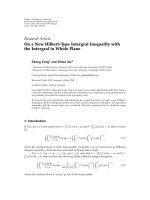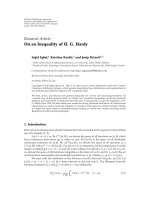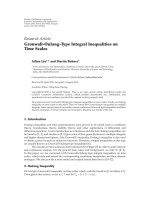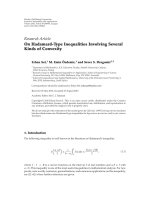báo cáo hóa học:" Research Article On Some Matrix Trace Inequalities ¨ ¨ ¨ Zubeyde Ulukok and Ramazan Turkmen" pdf
Bạn đang xem bản rút gọn của tài liệu. Xem và tải ngay bản đầy đủ của tài liệu tại đây (479.51 KB, 8 trang )
Hindawi Publishing Corporation
Journal of Inequalities and Applications
Volume 2010, Article ID 201486, 8 pages
doi:10.1155/2010/201486
Research Article
On Some Matrix Trace Inequalities
Z
¨
ubeyde Uluk
¨
ok and Ramazan T
¨
urkmen
Department of Mathematics, Science Faculty, Selc¸uk University, 42003 Konya, Turkey
Correspondence should be addressed to Z
¨
ubeyde Uluk
¨
ok,
Received 23 December 2009; Revised 4 March 2010; Accepted 14 March 2010
Academic Editor: Martin Bohner
Copyright q 2010 Z. Uluk
¨
ok and R. T
¨
urkmen. This is an open access article distributed under
the Creative Commons Attribution License, which permits unrestricted use, distribution, and
reproduction in any medium, provided the original work is properly cited.
We first present an inequality for the Frobenius norm of the Hadamard product of two any square
matrices and positive semidefinite matrices. Then, we obtain a trace inequality for products of two
positive semidefinite block matrices by using 2 × 2 block matrices.
1. Introduction and Preliminaries
Let M
m,n
denote the space of m × n complex matrices and write M
n
≡ M
n,n
. The identity
matrix in M
n
is denoted I
n
. As usual, A
∗
A
T
denotes the conjugate transpose of matrix
A. A matrix A ∈ M
n
is Hermitian if A
∗
A. A Hermitian matrix A is said to be positive
semidefinite or nonnegative definite, written as A ≥ 0, if
x
∗
Ax ≥ 0, ∀x ∈ C
n
. 1.1
A is further called positive definite, symbolized A>0, if the strict inequality in 1.1 holds
for all nonzero x ∈ C
n
. An equivalent condition for A ∈ M
n
to be positive definite is that A is
Hermitian and all eigenvalues of A are positive real numbers. Given a positive semidefinite
matrix A and p>0, A
p
denotes the unique positive semidefinite pth power of A.
Let A and B be two Hermitian matrices of the same size. If A − B is positive
semidefinite, we write
A ≥ B or B ≤ A. 1.2
Denote λ
1
A, ,λ
n
A and s
1
A, ,s
n
A eigenvalues and singular values of matrix A,
respectively. Since A is Hermitian matrix, its eigenvalues are arranged in decreasing order,
that is, λ
1
A ≥ λ
2
A ≥ ···≥λ
n
A and if A is any matrix, its singular values are arranged
in decreasing order, that is, s
1
A ≥ s
2
A ≥···≥s
n
A > 0. The trace of a square matrix A
2 Journal of Inequalities and Applications
the sum of its main diagonal entries, or, equivalently, the sum of its eigenvalues is denoted
by tr A.
Let A be any m × n matrix. The Frobenius Euclidean norm of matrix A is
A
F
⎡
⎣
m
i1
n
j1
a
ij
2
⎤
⎦
1/2
.
1.3
It is also equal to the square root of the matrix trace of AA
∗
, that is,
A
F
tr
AA
∗
.
1.4
Anorm·on M
m,n
is called unitarily invariant UAV A for all A ∈ M
m,n
and all
unitary U ∈ M
m
,V ∈ M
n
.
Given two real vectors x x
1
, ,x
n
and y y
1
, ,y
n
in decreasing order, we say
that x is weakly log majorized by y, denoted x ≺
w log
y,ifΠ
k
i1
x
i
≤ Π
k
i1
y
i
,k 1, 2, ,n,and
we say that x is weakly majorized by y, denoted x ≺
w
y,if
k
i1
x
i
≤
k
i1
y
i
,k 1, 2, ,n.We
say x is majorized by y denoted by x ≺ y,if
x ≺
w
y,
n
i1
x
i
n
i1
y
i
.
1.5
As is well known, x ≺
w log
y yields x ≺
w
y see, e.g., 1, pages 17–19.
Let A be a square complex matrix partitioned as
A
A
11
A
12
A
21
A
22
, 1.6
where A
11
is a square submatrix of A.IfA
11
is nonsingular, we call
A
11
A
22
− A
21
A
−1
11
A
12
1.7
the Schur complement of A
11
in A see, e.g., 2, page 175.IfA is a positive definite matrix,
then A
11
is nonsingular and
A
22
≥
A
11
≥ 0.
1.8
Recently, Yang 3 proved two matrix trace inequalities for positive semidefinite
matrices A ∈ M
n
and B ∈ M
n
,
0 ≤ tr
AB
2n
≤
tr A
2
tr A
2
n−1
tr B
2
n
,
0 ≤ tr
AB
2n1
≤
tr A
tr B
tr A
2
n
tr B
2
n
,
1.9
for n 1, 2,
Journal of Inequalities and Applications 3
Also, authors in 4 proved the matrix trace inequality for positive semidefinite
matrices A and B,
tr
AB
m
≤
tr
A
2m
tr
B
2m
1/2
,
1.10
where m is a positive integer.
Furthermore, one of the results given in 5 is
n
det A · det B
m/n
≤ tr
A
m
B
m
1.11
for A and B positive definite matrices, where m is any positive integer.
2. Lemmas
Lemma 2.1 see, e.g., 6. For any A and B ∈ M
n
,σA ◦ B≺
w
σA ◦ σB.
Lemma 2.2 see, e.g., 7. Let A, B ∈ M
m,n
, then
t
i1
δ
i
AB
2m
≤
t
i1
λ
i
A
∗
ABB
∗
m
≤
t
i1
λ
i
A
∗
A
m
BB
∗
m
, 1 ≤ t ≤ n, m ∈ N.
2.1
Lemma 2.3 Cauchy-Schwarz inequality. Let a
1
,a
2
, ,a
n
and b
1
,b
2
, ,b
n
be real numbers.
Then,
n
i1
a
i
b
i
2
≤
n
i1
a
2
i
n
i1
b
2
i
, ∀a
i
,b
i
∈ R.
2.2
Lemma 2.4 see, e.g., 8, page 269. If A and B are poitive semidefinite matrices, then,
0 ≤ tr
AB
≤ tr A tr B. 2.3
Lemma 2.5 see, e.g., 9, page 177. Let A and B are n × n matrices. Then,
k
i1
s
i
AB
≤
k
i1
s
i
A
s
i
B
1 ≤ k ≤ n
.
2.4
Lemma 2.6 see, e.g., 10. Let F and G are positive semidefinite matrices. Then,
t
i1
λ
m
i
FG
≤
t
i1
λ
i
F
m
G
m
, 1 ≤ t ≤ n,
2.5
where m is a positive integer.
4 Journal of Inequalities and Applications
3. Main Results
Horn and Mathias 11 show that for any unitarily invariant norm ·on M
n
A
∗
B
2
≤
A
∗
A
B
∗
B
∀A, B ∈ M
m,n
,
A ◦ B
2
≤
A
∗
A
B
∗
B
∀A, B ∈ M
n
.
3.1
Also, the authors in 12 show that for positive semidefinite matrix A
LX
X
∗
M
, where X ∈
M
m,n
|
X
|
p
2
≤
L
p
M
p
3.2
for all p>0 and all unitarily invariant norms ·.
By the following theorem, we present an inequality f or Frobenius norm of the power
of Hadamard product of two matrices.
Theorem 3.1. Let A and B be n-square complex matrices. Then
A ◦ B
m
2
F
≤
A
∗
A
m
F
B
∗
B
m
F
, 3.3
where m is a positive integer. In particular, if A and B are positive semidefinite matrices, then
A ◦ B
m
2
F
≤
A
2m
F
B
2m
F
.
3.4
Proof. From definition of Frobenius norm, we write
A ◦ B
m
2
F
tr
A ◦ B
m
A ◦ B
m∗
.
3.5
Also, for any A and B, it follows that see, e.g., 13
AA
∗
◦ BB
∗
A ◦ B
A
∗
◦ B
∗
I
≥ 0, 3.6
A ◦ B
A ◦ B
∗
≤ AA
∗
◦ BB
∗
. 3.7
Since |tr A
2m
|≤trA
m
A
∗
m
≤ trAA
∗
m
for A ∈ M
n
and from inequality 3.7, we write
A ◦ B
m
2
F
tr
A ◦ B
m
A ◦ B
m∗
≤ tr
A ◦ B
A ◦ B
∗
m
≤ tr
AA
∗
◦ BB
∗
m
.
3.8
Journal of Inequalities and Applications 5
From Lemma 2.1 and Cauchy-Schwarz inequality, we write
tr
A
m
◦ B
m
n
i1
λ
i
A
m
◦ B
m
≤
n
i1
λ
i
A
m
λ
i
B
m
≤
n
i1
λ
2
i
A
m
n
i1
λ
2
i
B
m
1/2
tr A
2m
tr B
2m
1/2
.
3.9
By combining inequalities 3.7, 3.8,and3.9, we arrive at
tr
AA
∗
◦ BB
∗
m
≤
tr
AA
∗
AA
∗
m
tr
BB
∗
BB
∗
m
1/2
≤
tr
AA
∗
AA
∗
m
tr
BB
∗
BB
∗
m
1/2
tr
AA
∗
2m
1/2
tr
BB
∗
2m
1/2
A
∗
A
m
F
B
∗
B
m
F
.
3.10
Thus, the proof is completed. Let A and B be positive semidefinite matrices. Then
A ◦ B
m
2
F
≤
A
2m
F
B
2m
F
,
3.11
where m>0.
Theorem 3.2. Let A
i
∈ M
n
i 1, 2, ,k be positive semidefinite matrices. For positive real
numbers s, m, t
k
i1
A
st/2m
i
2
F
2
≤
k
i1
A
sm
i
2
F
k
i1
A
tm
i
2
F
.
3.12
Proof. Let
A
⎛
⎜
⎜
⎜
⎜
⎜
⎜
⎜
⎝
A
S/2
1
0 ··· 0
0 A
s/2
2
··· 0
.
.
.
.
.
.
.
.
.
.
.
.
00··· A
s/2
k
⎞
⎟
⎟
⎟
⎟
⎟
⎟
⎟
⎠
,B
⎛
⎜
⎜
⎜
⎜
⎜
⎜
⎜
⎝
A
t/2
1
0 ··· 0
0 A
t/2
2
··· 0
.
.
.
.
.
.
.
.
.
.
.
.
00··· A
t/2
k
⎞
⎟
⎟
⎟
⎟
⎟
⎟
⎟
⎠
. 3.13
6 Journal of Inequalities and Applications
We know that A, B ≥ 0, then by using the definition of Frobenius norm, we write
A ◦ B
m
2
F
k
i1
A
st/2m
i
2
F
,
A
2m
F
k
i1
A
sm
i
2
F
,
B
2m
F
k
i1
A
tm
i
2
F
.
3.14
Thus, by using Theorem 3.1, the desired is obtained.
Now, we give a trace inequality for positive semidefinite block matrices.
Theorem 3.3. Let
A
A
11
A
12
A
21
A
22
≥ 0,B
B
11
B
12
B
21
B
22
≥ 0, 3.15
then,
tr
A
22
1/2
B
1/2
11
2m
tr
A
1/2
22
B
11
1/2
2m
≤ tr
AB
m
≤ tr
A
m
B
m
, 3.16
where m is an integer.
Proof. Let
M
X 0
YZ
3.17
with Z A
1/2
22
,Y A
−1/2
22
A
21
,X A
11
− A
12
A
−1
22
A
21
1/2
. Then A M
∗
M see, e.g., 14.Let
K
X 0
YZ
3.18
with Z B
22
− B
21
B
−1
11
B
12
1/2
, Y B
21
B
−1/2
11
, X B
1/2
11
. Then B KK
∗
see, e.g., 14.We
know that
M
k
X
k
0
∗ Z
k
,
M · K
⎡
⎣
A
11
− A
12
A
−1
22
A
21
1/2
B
1/2
11
0
A
−1/2
22
A
21
B
1/2
11
A
1/2
22
B
21
B
−1/2
11
A
1/2
22
B
22
− B
21
B
−1
11
B
12
1/2
⎤
⎦
,
Journal of Inequalities and Applications 7
M · K
2m
⎡
⎢
⎣
A
11
− A
12
A
−1
22
A
21
1/2
B
1/2
11
2m
0
∗
A
1/2
22
B
22
− B
21
B
−1
11
B
12
1/2
2m
⎤
⎥
⎦
.
3.19
By using Lemma 2.2, it follows that
tr
MK
2m
≤
n
i1
s
i
MK
2m
≤
n
i1
s
i
MK
2m
n
i1
s
2
i
MK
m
n
i1
λ
i
M
∗
MKK
∗
m
n
i1
λ
i
AB
m
n
i1
tr
AB
m
≤
n
i1
λ
i
M
∗
M
m
KK
∗
m
n
i1
λ
i
A
m
B
m
n
i1
tr
A
m
B
m
.
3.20
Therefore, we get
tr
MK
2m
tr
A
11
− A
12
A
−1
22
A
21
1/2
B
1/2
11
2m
tr
A
1/2
22
B
22
− B
21
B
−1
11
B
12
1/2
2m
≤ tr
AB
m
≤ tr
A
m
B
m
.
3.21
As result, we write
tr
A
22
1/2
B
1/2
11
2m
tr
A
1/2
22
B
11
1/2
2m
≤ tr
AB
m
≤ tr
A
m
B
m
.
3.22
Example 3.4. Let
A
41
11
> 0,B
52
21
> 0. 3.23
Then tr AB 25, det A 3, det B 1. From inequality 1.11,form 1, we get
n
det A det B
1/n
2
√
3
∼
3.464
. 3.24
8 Journal of Inequalities and Applications
Also, for m 1, since tr
A
22
1/2
B
1/2
11
2
15 and tr A
1/2
22
B
11
1/2
2
0.2, we get
tr
A
22
1/2
B
1/2
11
2
tr
A
1/2
22
B
11
1/2
2
15.2.
3.25
Thus, according to this example from 3.24 and 3.25,weget
n
det A det B
1/n
≤ tr
A
22
1/2
B
1/2
11
2
tr
A
1/2
22
B
11
1/2
2
≤ tr
AB
.
3.26
Acknowledgment
This study was supported by the Coordinatorship of Selc¸uk University’s Scientific Research
Projects BAP.
References
1 X. Zhan, Matrix Inequalities, vol. 1790 of Lecture Notes in Mathematics, Springer, Berlin, Germany, 2002.
2 F. Zhang, Matrix Theory: Basic Results and Techniques, Universitext, Springer, New York, NY, USA, 1999.
3 X. Yang, “A matrix trace inequality,” Journal of Mathematical Analysis and Applications, vol. 250, no. 1,
pp. 372–374, 2000.
4 X.M.Yang,X.Q.Yang,andK.L.Teo,“Amatrixtraceinequality,”Journal of Mathematical Analysis and
Applications, vol. 263, no. 1, pp. 327–331, 2001.
5 F. M. Dannan, “Matrix and operator inequalities,” Journal of Inequalities in Pure and Applied
Mathematics, vol. 2, no. 3, article 34, 7 pages, 2001.
6 F. Z. Zhang, “Another proof of a singular value inequality concerning Hadamard products of
matrices,” Linear and Multilinear Algebra, vol. 22, no. 4, pp. 307–311, 1988.
7 Z. P. Yang and X. X. Feng, “A note on the trace inequality for products of Hermitian matrix power,”
Journal of Inequalities in Pure and Applied Mathematics, vol. 3, no. 5, article 78, 12 pages, 2002.
8 E. H. Lieb and W. Thirring, Studies in Mathematical Physics, Essays in Honor of Valentine Bartmann,
Princeton University Press, Princeton, NJ, USA, 1976.
9 R. A. Horn and C. R. Johnson, Topics in Matrix Analysis, Cambridge University Press, Cambridge, UK,
1991.
10 B. Y. Wang and M. P. Gong, “Some eigenvalue inequalities for positive semidefinite matrix power
products,” Linear Algebra and Its Applications, vol. 184, pp. 249–260, 1993.
11 R. A. Horn and R. Mathias, “An analog of the Cauchy-Schwarz inequality for Hadamard products
and unitarily invariant norms,” SIAM Journal on Matrix Analysis and Applications, vol. 11, no. 4, pp.
481–498, 1990.
12 R. A. Horn and R. Mathias, “Cauchy-Schwarz inequalities associated with positive semidefinite
matrices,” Linear Algebra and Its Applications, vol. 142, pp. 63–82, 1990.
13 F. Zhang, “Schur complements and matrix inequalities in the L
¨
owner ordering,” Linear Algebra and Its
Applications, vol. 321, no. 1–3, pp. 399–410, 2000.
14 C K. Li and R. Mathias, “Inequalities on singular values of block triangular matrices,” SIAM Journal
on Matrix Analysis and Applications, vol. 24, no. 1, pp. 126–131, 2002.









